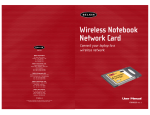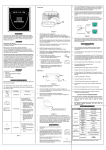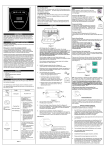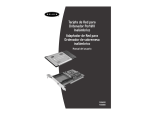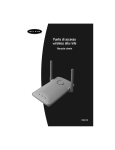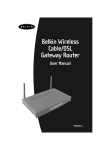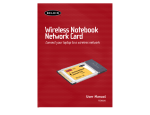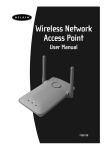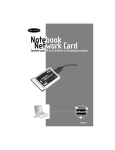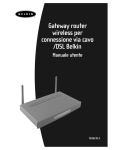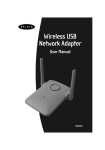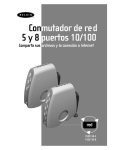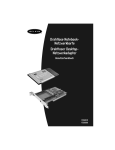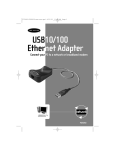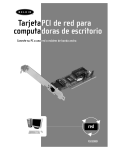Download F5D6020_v1
Transcript
Wireless Notebook
Network Card
Wireless Desktop
Network Adapter
User Manual
F5D6020
F5D6000
Table of Contents
Introduction . . . . . . . . . . . . . . . . . . . . . . . . . . . . . . . . . . . . . . . . . . . . . . . . . . 1
Overview . . . . . . . . . . . . . . . . . . . . . . . . . . . . . . . . . . . . . . . . . . . . . . . . . . . 2
Installing the Wireless Notebook Network Adapter using the
Optional PCI Adapter . . . . . . . . . . . . . . . . . . . . . . . . . . . . . . . . . . . . . . . . 3–4
Installing the PCI drivers for Windows 95 . . . . . . . . . . . . . . . . . . . . . . . . . 5–6
Installing the PCI drivers for Windows 98/Me . . . . . . . . . . . . . . . . . . . . . . . 7–8
Installing the PCI drivers for Windows 2000 . . . . . . . . . . . . . . . . . . . . . . 9–11
Installing the PCI drivers for Windows NT . . . . . . . . . . . . . . . . . . . . . . . 12–13
Installing the Notebook Network Card in your Notebook PC . . . . . . . . . . . . 14
Installing the Notebook Network Card Drivers for Windows 95 . . . . . . . 15–16
Installing the Notebook Network Card Drivers for Windows 98/Me . . . . 17–18
Installing the Notebook Network Card Drivers for Windows 2000 . . . . . 19–20
Installing the Notebook Network Card Drivers for Windows NT . . . . . . 21–22
Installing Belkin 11Mbps Wireless Setup Utility . . . . . . . . . . . . . . . . . . . . . . 23
Using the Belkin 11Mbps Wireless Setup Utility . . . . . . . . . . . . . . . . . . 24–30
Installing the Belkin SOHO Networking Software for Windows 98/Me . . . . 31
Configuring Your Windows 98/Me Computer Using Belkin NetSetup . . . 32–33
Configuring Additional Computers Using Belkin NetSetup Software . . . 34–35
Sharing Files and Peripherals . . . . . . . . . . . . . . . . . . . . . . . . . . . . . . . . . 36–38
Accessing Resources on Other Computers . . . . . . . . . . . . . . . . . . . . . . . . . . 39
Glossary of Wireless Networking Terms . . . . . . . . . . . . . . . . . . . . . . . . . 40–41
Glossary of Wired Networking Terms . . . . . . . . . . . . . . . . . . . . . . . . . . . 42–43
Information . . . . . . . . . . . . . . . . . . . . . . . . . . . . . . . . . . . . . . . . . . . . . . 44–46
Introduction
Thank You for purchasing the Belkin 11Mbps Wireless Desktop Network
Adapter and/or the Belkin 11Mbps Wireless Notebook Network Card.
Now you can take advantage of the wireless world of networking that
frees you from using cables with your home or office network. The
Wireless Network Card Adapter serves as a way for your PCs to
communicate on a wireless network.
Features
• Compatible with PCMCIA and PCI specifications
• Provides LED indicators for monitoring network traffic
Contents of Package
• One Wireless Notebook Network Card or One Wireless Desktop
Network Adapter
• One CD-ROM
• User Guide
1
Overview
There are two ways to use your Wireless Notebook Network Adapter.
1. Use in a desktop computer with the optional PCI adapter. If you are using
the Optional PCI adapter, go to the section on page 3 titled "Installing the
Wireless Notebook Network Adapter using the Optional PCI Adapter"
2. Use in a laptop with PCMCIA slot. If your are installing your card directly
into a laptop computer, skip to the section on page 14 titled “Installing
the Notebook Network Card in your Notebook PC”.
2
Installing the Wireless Notebook Network Adapter
using the Optional PCI Adapter
1. Network cards are sensitive to static electricity, which can damage their
delicate electronic components. To protect your device, always: Touch the
metal chassis of your computer before you pick up the card. This grounds
the electrostatic charge. Avoid touching any of the electrical components
when handling the card. If possible, wear a grounded wrist strap or antistatic gloves.
Note: Dry weather conditions or walking across a carpeted floor may
cause you to acquire an electrostatic charge.
2. Turn off the power to the PC and unplug the power cord from the
electrical outlet.
3. Remove the cover to the PC. Please refer to your computer’s Owner’s
Manual for instructions on how to remove the cover.
4. Find any available PCI expansion bus slot and
remove the protector bracket from the
computer’s case.
5. Carefully insert the
Wireless Desktop
Network Card into
the slot until the
connectors at the
edge of the card
are firmly in place.
3
Installing the Wireless Notebook Network Adapter
using the Optional PCI Adapter
6. Secure the card into the
slot using a standard
case screw.
7. Carefully insert the Wireless
Notebook Network Card into
the slot on the Wireless
Desktop Network Adapter until
it connects to the Network
adapter. The PCMCIA card
MUST be installed into the PCI
adapter before installing the
software drivers.
8. Replace the cover to the PC
and connect the power cord to
the electrical outlet. Be sure to
re-connect other cables that
may have come loose during
the installation.
Your hardware is now installed. Next you need to install the PCI software
drivers for your operating system. The next section in the manual explains
how to install the PCI software drivers for your particular operating system.
Find the appropriate instructions for your operating system and follow them.
4
Installing the PCI drivers for Windows 95
1. Turn on the power to the PC.
After Windows starts up,
Windows will automatically
detect that a new device has
been installed and will display
the following windows. Insert the
CD into your CD-ROM drive.
2. Windows will tell you that it is
unable to locate a driver. Click
"Other Locations…"
3. The screen below will appear. Make sure that the CD is inserted into your
CD-ROM drive. In the "Location" bar, type "D:\": where "D:\" is the drive
letter of your CD-ROM Drive.
5
Installing the PCI drivers for Windows 95
4. Windows will install the
drivers from the CD-ROM
drive. The window below will
appear. Click "Finish".
5. Windows may ask you to
insert the Windows 95 CD.
Insert your Windows 95 CD into the CD-ROM drive and click "OK".
6. Windows will now ask you to restart. Click "Yes" to restart your computer.
Hardware and software driver installation is now complete for
Windows 95. The next step is to install the Belkin 11Mbps Wireless Setup
Utility. Go to page 23.
6
Installing the PCI drivers for Windows 98/Me
1. Turn on the power to the
PC. After Windows starts
up, Windows will
automatically detect that a
new device has been
installed and will display
the following window:
2. The "Add New Hardware Wizard" will begin. Click "Next".
3. When asked, "What do you
want Windows to do?" select
"Search for the best driver for
your device. (Recommended)"
and click "Next".
4. Select "CD-ROM". Place the
CD-ROM supplied with the
card in your CD-ROM drive
and click "Next".
7
Installing the PCI drivers for Windows 98/Me
5. Windows will find the
appropriate drivers and the
following screen will appear:
Click "Next".
6. The following screen will
appear: Click "OK".
7. Click on the Finish Button to
complete the wizard. Your
computer may prompt you to
restart, if so, allow the system
to restart.
Hardware and software driver installation is now complete for Windows
98/ME. The next step is to install the Belkin 11Mbps Wireless Setup Utility.
Go to page 23.
8
Installing the PCI drivers for Windows 2000
1. Turn on the power to the PC. After Windows starts up, Windows will
automatically detect that a new device has been installed and will display
the following window:
2. The "Found New
Hardware Wizard" will
start. Click "Next".
3. In the next screen, select
"Search for a suitable
driver for my device
(recommended)" then
click "Next".
9
Installing the PCI drivers for Windows 2000
4. This screen will appear.
Insert the CD (provided
with the card) into your
CD-ROM drive. Select
"CD-ROM drive" then
click "Next".
5. This screen will appear.
Click "Next".
6. The "Digital Signature
Not Found" screen will
appear. This does not
mean there is a problem.
Click "Yes" to continue.
10
Installing the PCI drivers for Windows 2000
7. Windows will install the drivers. When finished, the screen below will
appear. Click "Finish" to complete the installation. If Windows prompts
you to restart your computer, do so.
Hardware and software driver installation is now complete for Windows
2000. The next step is to install the Belkin 11Mbps Wireless Setup Utility.
Go to page 23.
11
Installing the PCI drivers for Windows NT
Since Windows® NT is not a plug-and-play operating system, it will not
automatically detect the installation of the PCI adapter. To manually
install the PCI Software Drivers, follow the steps below. After Windows
NT starts up,
1. Turn on the power to the PC. After Windows NT starts up, insert the CD
into your CD-ROM drive.
2. Click on "Start", select
"Settings" then click on
"Control" panel to open the
"Control Panel" Window.
3. Double-click on the "Network
Icon". The screen below will
appear. A list of adapter may
appear in the window, however
the Belkin PCI adapter will not.
Click on "Add".
12
Installing the PCI drivers for Windows NT
4. In the next screen, type
"D:\" where D:\ is the
drive letter of your CDROM drive. Click "OK".
5. Select "Belkin 11Mbps
Wireless PCI Adapter Card"
then click "OK".
6. This screen will appear.
Click "OK".
Hardware and driver installation is now complete for Windows NT. The
next step is to install the Belkin 11Mbps Wireless Setup Utility. Go to
page 23.
13
Installing the Notebook Network Card in your Notebook PC
1. Insert the Wireless Notebook Network Card in the PCMCIA slot of your
notebook with the color label facing up.
2. Install the drivers for your particular operating system. Go to the next
section that applies to your operating system.
14
Installing the Notebook Network Card Drivers for Windows 95
1. Turn on the power to your
laptop PC. After Windows
starts up, Windows will
automatically detect that a
new device has been
installed and will display
the windows Below. Insert
the CD into your
CD-ROM drive.
2. Windows will tell you that
it is unable to locate a
driver. Click "Other
Locations…"
3. The screen below will appear. Make sure that the CD is inserted into your
CD-ROM drive. In the "Location" bar, type "D:\": where "D:\" is the drive
letter of your CD-ROM Drive.
15
Installing the Notebook Network Card Drivers for Windows 95
4. Windows will install the
drivers from the CD-ROM
drive. The window below
will appear. Click "Finish".
5. Windows may ask you to
insert the Windows 95
CD. Insert your Windows
95 CD into the CD-ROM
drive and click "OK".
6. Windows will now ask you to restart. Click "Yes" to restart your computer.
Hardware and software driver installation is now complete for
Windows 95. The next step is to install the Belkin 11Mbps Wireless Setup
Utility. Go to page 23.
16
Installing the Notebook Network Card Drivers for Windows 98/Me
1. Insert the PCMCIA card into
your Notebook PC. Turn on
the power to the PC. After
Windows 98/Me starts up, the
"Add New Hardware Wizard"
will begin. Click "Next".
2. When asked, "What do you
want Windows to do?" select
"Search for the best driver for
your device. (Recommended)"
and click "Next".
3. Select "CD-ROM". Place
the CD-ROM supplied
with the card in your
CD-ROM drive and
click "Next".
17
Installing the Notebook Network Card Drivers for Windows 98/Me
4. Windows will find the
appropriate drivers and the
following screen will appear:
Click "Next".
5. The following screen will
appear: Click "OK".
6. Click on the Finish Button to
complete the wizard. Your
computer may prompt you to
restart, if so, allow the system
to restart.
Hardware and software driver installation is now complete for Windows
98/ME. The next step is to install the Belkin 11Mbps Wireless Setup Utility.
Go to page 23.
18
Installing the Notebook Network Card Drivers for Windows 2000
1. Insert the PCMCIA card into your Notebook PC. Turn on the power to
the PC. After Windows 2000 starts up, insert the CD into your
CD-ROM drive.
2. The "Found New
Hardware Wizard" will
start. Click "Next".
3. In the next screen, select
"Search for a suitable
driver for my device
(recommended)" then
click "Next".
4. The screen below will
appear. Insert the CD
(provided with the card)
into your CD-ROM drive.
Select "CD-ROM drive"
then click "Next".
19
Installing the Notebook Network Card Drivers for Windows 2000
5. This screen will appear.
Click "Next".
6. The "Digital Signature Not
Found" screen will appear.
This does not mean there
is a problem. Click "Yes"
to continue.
7. Windows will install the
drivers. When finished,
the screen below will
appear. Click "Finish" to
complete the installation.
If Windows prompts you
to restart your computer,
do so.
Hardware and software driver installation is now complete for Windows
2000. The next step is to install the Belkin 11Mbps Wireless Setup
Utility. Go to page 23.
20
Installing the Notebook Network Card Drivers for Windows NT
1. Insert the PCMCIA card into your Notebook PC. Turn on the power
to the PC. After Windows NT starts up, insert the CD into your
CD-ROM drive.
2. Click on "Start", select
"Settings" then click
on "Control" panel to
open the "Control
Panel" Window.
3. Double-click on the "Network Icon".
The screen below will appear. A list
of adapter may appear in the
window, however the Belkin PCI
adapter will not. Click on "Add".
4. The screen below will appear. Select
"Have Disk".
21
Installing the Notebook Network Card Drivers for Windows NT
5. In the next screen, type
"D:\" where D:\ is the drive
letter of your CD-ROM
drive. Click "OK".
6. Select "Belkin 11Mbps
Wireless PCI Adapter Card"
then click "OK".
7. This screen will appear.
Click "OK".
Hardware and driver installation is now complete for Windows NT.
The next step is to install the Belkin 11Mbps Wireless Setup Utility.
Go to page 23.
22
Installing Belkin 11Mbps Wireless Setup Utility
The Belkin 11Mbps Wireless Setup Utility allows you to setup the
Wireless Network Card/Adapter’s wireless Ethernet settings.
1. Insert the CD-ROM that came with your Belkin Wireless Notebook
Network Card or Belkin Wireless Desktop Adapter into your CD-ROM.
2. From your desktop, double-click on "My Computer", then double-click
on your CD-ROM Drive.
3. Double-click on the Setup icon. Windows will automatically install the
program onto your PC. After the program is installed, Windows may
ask you to restart your computer. Please do so.
23
Using the Belkin 11Mbps Wireless Setup Utility
The Belkin 11Mbps Wireless Setup Utility will launch automatically when
your computer starts with a Wireless adapter installed. To launch the
Belkin 11Mbps Wireless Setup Utility manually, click "Start", "Programs",
then select "Belkin 11Mbps Network" and select "Configuration Utility".
When the utility is running, the Icon below will appear in the system tray.
When the icon is green it indicates that the wireless link is good. When
the icon is yellow, it indicates that the wireless link is fair. When the icon
is red, there is no link established.
(green)
(yellow)
(red)
To make any changes to the configuration of your network use the
Wireless Setup Utility.
1. Click on the
icon found in your icon tray of your PC.
2. The following screen
will appear:
1
3
2
4
5
6
24
Using the Belkin 11Mbps Wireless Setup Utility
1. State
Associated: The PC is connected to the wireless network.
Scanning:
The PC is searching for an available Wireless Network Access
Point (WAP). If "associated" does not appear, the card cannot
detect the SSID for the WAP.
2. Current Channel
Each country’s regulatory commission (FCC for the US) has a specified set
of channels for 802.11b to operate on. Each country is different. To
comply with the standards for each country, the Wireless Network
Cards/Adapters must be set to any number between 1 and 11.
3. Rescan Button
Clicking on the Rescan button will cause the Wireless Network Card to
find the associated Ad Hoc network or the WAP's SSID.
4. Current Tx Rate
This shows the speed of your network connection using the Wireless
Network Card.
5. Throughput
Tx: This field shows the wireless transmission throughput in bytes
per second.
Rx: This field shows the wireless receipt throughput in bytes
per second.
6. Link Quality/Signal Strength
This is only available when the Wireless Desktop Network Adapter is
running in infrastructure mode. The link quality bar indicates the quality
of the link between the PC and the WAP. The signal strength bar indicates
the quality of the link coming from the radio waves.
25
Using the Belkin 11Mbps Wireless Setup Utility
Click-on the Configuration tab and the following screen will appear:
1
2
4
3
1. Mode
Infrastructure Mode
A setup that uses a WAP to connect a wireless LAN to a wired LAN is called
an infrastructure configuration, and the setup is referred to as being in
Infrastructure Mode. The WAP serves as a bridge between the wired and
wireless network. Connecting the WAP to any port on the wired network will
give wireless access to all wireless equipped computers within its coverage
area. An WAP is configured with a Service Set Identifier. This is a "name" that is
given to the wireless network and is used by the wireless equipped computers
to access the wireless network. The WAP can also be configured to use
encryption or grant access to computers with specific MAC addresses. The
WAP also effectively doubles the distance that computers in the wireless LAN
can be located from one another. This is because the WAP serves as a central
point for routing of all the wireless network traffic between the wireless
computers. Wireless equipped computers networked together in infrastructure
mode form a group called a Basic Service Set (BSS). Up to 64 individual
26
Using the Belkin 11Mbps Wireless Setup Utility
computers can exist at a single time in a BSS. This is due to the ability of the
WAP to handle no more than 64 clients. The diagram below illustrates how the
access point will effectively double the distance between wireless equipped
computers in a BSS.
Notebook with Wireless
Notebook Network Card
Wireless Network
Access Point
Notebook with Wireless
Notebook Network Card
PC with Wireless Desktop
PCI Network Adapter
Infrastructure mode: This is used when you want to connect your wired network to
your wireless network. Often, Infrastructure Mode is used when there is use of a WAP.
Ad-Hoc Mode
Ad-Hoc or Peer-to-Peer refers to a configuration in which each computer in a
wireless network communicates directly with another. An Ad-Hoc wireless
LAN consists of a group of computers, each equipped with a wireless adapter,
connected directly via radio signals to form an independent wireless LAN.
Computers in a specific Ad-Hoc wireless LAN must be configured to the same
radio channel to communicate with one another. More than one Ad-Hoc
network can exist in the same space if it is configured to operate on a different
channel. There are a varying number of channels depending on the part of the
world you are operating in. The US has 11 channels, Europe has 13 channels
and Japan has 14 channels. The following diagram shows a typical Ad-Hoc
wireless LAN configuration.
27
Using the Belkin 11Mbps Wireless Setup Utility
Notebook with
Wireless Notebook
Network Card
Notebook with
Wireless Notebook
Network Card
PC with Wireless Desktop
PCI Network Adapter
Ad-Hoc mode: This is used when the network is set up wirelessly. This mode allows wireless
PC card to wireless PC card communications and does not require the use of a WAP.
2. SSID
The Service Set Identifier (SSID) is like a name for the wireless network and is
sometimes called the "Network Name".
Infrastructure mode: The SSID should be set to the same value as the WAP.
Ad-Hoc mode:
The SSID on all Wireless Notebook Network Cards in the
network are set to the same value.
3. PS Mode
The power save mode enables or disables the PC from going into sleep mode.
Enabled: Allows your PCs to enter sleep mode, but this can disrupt steady
communication when the PC goes to sleep
Disabled: Disables PC from going into sleep mode and will allow
uninterrupted data communication over your network.
4. Restore Defaults
To restore the factory default settings, click on the restore defaults button. The
Wireless Notebook Network Card settings will be restored.
28
Using the Belkin 11Mbps Wireless Setup Utility
Click-on the Encryption tab and the following screen will appear:
Encryption
For secure data transmissions the Belkin Wireless Desktop Network
Adapters are capable of encrypting, or "scrambling" the information that is
sent over the air between your computers. The WAP uses a form of
encryption called WEP (Wired Equivalent Privacy). There are two levels of
WEP encryption, 64-bit and 128-bit. As the numbers imply, 128-bit
encryption is more secure than 64-bit encryption. However, using 128-bit
encryption uses keys to scramble and unscramble the data that is being
sent between the wireless equipped computers. The wireless network
must use the same key to be able to communicate using encryption.
Select 64-bit from the drop-down menu. You will notice when using
64-bit encryption there are 4 keys labeled, "Key 1" through "Key 4". Only
one key can be used at a time. Keys can be entered manually, but for ease
of use, the software can generate keys using a "Passphrase" that you enter.
This passphrase can be easily distributed to wireless equipped computer
users in your network. For instance, creating a key using the passphrase
29
Using the Belkin 11Mbps Wireless Setup Utility
"Passphrase" generates four keys in 64-bit encryption mode and one key
in 128-bit encryption mode. A user of a laptop needs only to enter the
passphrase and the key number into their computer’s wireless
management software to be able to communicate while using encryption.
All computers on the network must use the same encryption rate and
passphrase. The passphrase can be changed as often as desired.
Setting 64-Bit Encryption
1. Select 64-bit from the drop-down menu.
2. Select "Create with Passphrase".
3. Enter a Passphrase and click "Apply".
4. Select the "Default Key ID" from the drop-down menu. These are
labeled 1 – 4. Click "Apply".
64-bit encryption is now enabled.
Setting 128-bit Encryption
1. Select 128-bit from the drop-down menu.
2. Select "Create with Passphrase"
3. Enter a Passphrase and click "Apply"
128-bit encryption is now enabled.
30
Installing the Belkin SOHO Networking Software
for Windows 98/Me
The Belkin SOHO Networking software provides a simple way to setup your
Windows 98/Me computers for networking, file and printer sharing. If you
are familiar with TCP/IP and know how to configure the file and printer
sharing, it is not necessary to use the Belkin SOHO Networking software.
Now that your wireless network card/adapter drivers have been installed,
you can configure the network. For each computer you connect to the
network, you must assign a network address to be used by the other
computers. Belkin has simplified this process by providing you with the
Belkin SOHO Networking Software to configure your computers. Make sure
that no other network adapters are installed in your computer before running
the SOHO Networking Software.
1. Insert the SOHO Networking Software that came with your Belkin Wireless
Notebook Network Card or Wireless Desktop Network Adapter into your
CD-ROM.
2. Click Start, click Run, and type "D:\NetSetup." ("D" is usually the default
drive letter for the CD-ROM drive, if necessary, adjust drive letter to reflect
your designated CD-ROM drive letter.
3. Click OK and Windows will begin to install the program onto your PC.
After the program is installed, Windows may ask you to restart your
computer. Please do so.
4. Repeat these steps for each computer that you are connecting to
your network.
5. Once you have installed the Belkin SOHO Networking Software on all of
your computers, continue on to the next section.
31
Configuring Your Windows 98/Me Computer Using Belkin NetSetup
1. Once your computer has
restarted, click "Start", "Programs",
highlight "Belkin SOHO
Networking" and select "Belkin
NetSetup" to launch this easy-touse computer configurator. The
following screen will appear:
2. Select "I am setting up my own
network" and click "Next". The
following screen will appear.
Select "I am setting up the first
computer in my network" and
click "Next".
3. You will need to enter some information into the next screen that appears:
4. In the "Computer Name" field,
type a name for the computer
such as "Computer 1". The name
must be different for each
computer that belongs to the
same network/workgroup.
5. In the "Workgroup" field, type a
workgroup name such as "My
Network". The workgroup name
must be same for each network
or workgroup.
32
Configuring Your Windows 98/Me Computer Using Belkin NetSetup
6. Use description field to further
identify the computer. Type in a
description such as "Windows
98". This can be anything you
want and does not have to be
different from or the same as the
description of any other
computer on the network. You
may also leave this field blank.
Click Next and the following
screen will appear:
7. If you want to share files and printers
on this computer, select "I want to
share files and printers on my
computer" and click "Finish." The
following screen will appear:
8. NetSetup now needs to know if you want to create a client setup floppy
disk. If you have more computers that you need to set up to work with the
wireless network, click "Yes". This will save some setup files to a disk,
simplifying setup of subsequent computers. If you are not going to set up
any more computers, click No and move to step 11.
9. If you clicked Yes, you will be prompted to insert a floppy disk into the PC’s
floppy disk drive. Label a floppy disk "Belkin Networking" and insert it into
the floppy disk drive. Click OK.
10. After the client setup disk has been created, you will be prompted to restart
your computer. So, please restart your computer.
33
Configuring Additional Computers Using Belkin NetSetup Software
Now that the first computer has been configured we are ready to configure the
other PCs on your network.
1. You should now be working
with the next computer. Click
Start, Programs, Belkin SOHO
Networking, and then Belkin
NetSetup to launch the easy-touse computer configurator the
following screen will appear:
2. Select "I am adding this
computer to my network".
Click "Next".
3. Windows will now prompt you to insert the newly created client setup disk
into the PC’s floppy drive. Insert the disk you labeled "Belkin Networking"
into the floppy drive and click OK. The following screen will appear:
4. In the "Computer Name" field,
type a name for the computer
such as "Computer 2".
Remember, the name must be
different from that of the other
computers on the network.
5. The "Workgroup" field should be
filled in with the workgroup
name you entered on the
previous computer. Do not
change this setting.
6. Type in a description such as "Windows 98". This can be anything you want
and does not have to be different from or the same as the description of any
other computer on the network. You may also leave this field blank.
34
Configuring Additional Computers Using Belkin NetSetup Software
7. When finished filling in the fields,
click "Next". The following screen
will appear:
8. If you want to share files and
printers on this computer, select "I
want to share files and printers on
my computer" and click "Finish".
If not, select "I do not want to
share files and printers on my
computer" and click "Finish".
9. You must now restart the computer.
10. Your PC is now configured. Repeat these steps for the rest of the computers
on your network.
35
Sharing Files and Peripherals
To enable file sharing and access between network computers to hard
drives, floppy drives, or CD-ROM drives, you must set sharing settings for
each PC in the network.
Belkin has simplified the sharing of files, peripherals, and internet
connections by providing you with the Belkin NetShare Utility to set up
your sharing options.
1. From the Start menu, click
Programs and select Belkin
NetShare Utility to set up
your sharing options. The
following screen will appear:
2. The Network Info tab allows
you to change the name of
the computer and the
workgroup. Verify that the
computer name and
workgroup match what you
entered in the Belkin
NetSetup Software.
3. You can click the
Browse Your Network
button as a shortcut to
your Network
Neighborhood or My
Network Places.
36
Sharing Files and Peripherals
4. If you double-click on the Entire Network icon, all network resources
available to you will be accessible.
5. If you press the File Sharing tab
the following screen will appear:
6. This screen will show you all the
PC drives available for sharing
with the entire network. To make
a drive accessible to all PCs in
your network, highlight the drive
in the left-hand column and
select Share.
7. To stop sharing highlight the
drive in the right hand column
and click Stop Sharing. The
drive(s) will appear in the left
hand column.
8. For advanced sharing options click on
the Properties button and the following
screen will appear:
9. On this screen you can share files on
your computer as read only or
read/write files. In addition, you can set
passwords so only authorized users can
change these settings.
37
Sharing Files and Peripherals
10.Click on the Printers tab
and the following screen
will appear:
11.This screen will list all printers
connected to your PC. Highlighting the
printer you would like to share (or not
share) and select the Sharing button the
following screen will appear:
12.Select the preferred sharing option for
this printer.
13.Clicking on Connect to Network Printers will allow you to locate shared
printers on your network. Once you have located the printer you want to
share over the network, NetShare will automatically install printers from the
host computer.
38
Accessing Resources on Other Computers
1. From the Start menu, go to
Programs and select Belkin
NetShare Utility. The following
screen will appear:
2. Select Browse Your
Network. The following
screen will appear:
3. Double-click on the Entire
Network icon and your
workgroup will appear.
Click on your workgroup
and all resources available
to you will be listed.
OR
1. To access resources available on other computers, click on the Network
Neighborhood or My Network Places icon on your desktop.
2. Double-click on the computer that you wish to access.
3. You can now access all network files that are available to you.
39
Glossary of Wireless Networking Terms
Ad-Hoc
An Ad-Hoc wireless LAN is a group of computers each with
LAN adapters, connected as an independent wireless LAN.
Notebook with
Wireless Notebook
Network Card
Notebook with
Wireless Notebook
Network Card
Ad-Hoc Mode
PC with Wireless Desktop
PCI Network Adapter
Backbone
The core infrastructure of a network. The portion of the
network that transports information from one central
location to another central location where it is unloaded
onto a local system.
Base Station
In mobile telecommunications, a base station is the central
radio transmitter/receiver that maintains communications
with the mobile radiotelephone sets within its range. In
cellular and personal communications applications, each cell
or micro-cell has its own base station; each base station in
turn is interconnected with other cells or bases.
BSS
BSS stands for Basic Service Set. A Basic Service Set is
comprised of a WAP and all the LAN PCs that are associated
with it.
ESS
ESS (ESS-ID, SSID) stands for Extended Service Set. More than
one BSS is configured to become an Extended Service Set.
LAN mobile users can roam between different BSSes in an
ESS (ESS-ID, SSID).
Ethernet
A popular local area data communications network, which
accepts transmission from computers and terminals. Ethernet
operates on a 10 or 100Mbps base band transmission rate,
using an unshielded, twisted-pair cable.
40
Glossary of Wireless Networking Terms
Infrastructure
An integrated wireless and wired LAN is called an
Infrastructure configuration.
Roaming
A wireless LAN mobile user moves around an ESS
and maintains a continuous connection to the
Infrastructure network.
Desktop PC
Notebook with Wireless
Notebook Network Card
Switch
Desktop PC
BSS2
Notebook with Wireless
Notebook Network Card
Wireless Network
Access Point
ESS
Wireless
Access Point
BSS1
Infrastructure Mode,
BSS, and ESS
PC with Wireless Desktop
PCI Network Adapter
RTS Threshold
Transmitters contending for the medium may not be
aware of each other. RTS/CTS mechanisms can solve this
"Hidden Node Problem". If the packet size is smaller than
the preset RTS Threshold size, the RTS/CTS mechanism
will not be enabled.
WEP
Wired Equivalent Privacy is based on the use of 64-bit or
28-bit keys and the popular RC4 encryption algorithm.
Wireless devices without a valid WEP key will be
excluded from network traffic.
Wireless Access
Point (WAP)
An internetworking device that seamlessly connects
wired and wireless networks.
41
Glossary of Wired Networking Terms
DHCP
DNS Server
Address
Dynamic Host Configuration Protocol. This protocol
automatically configures the TCP/IP settings of every
computer on your home network.
DNS stands for Domain Name System, which allows Internet
host computers to have a domain name (such as belkin.com)
and one or more IP addresses (such as 192.34.45.8). A DNS
server keeps a database of host computers and their
respective domain names and IP addresses, so that when a
domain name is requested (as in typing "belkin.com" into
your Internet browser), the user is sent to the proper IP
address. The DNS server address used by the computer on
your home network is the location of the DNS server your
ISP has assigned.
DSL Modem
DSL stands for Digital Subscriber Line. A DSL modem uses
your existing phone lines to transmit data at high speeds.
Ethernet
A standard for computer networks. Ethernet networks are
connected by special cables and switches, and move data
around 100Mbps.
IP Address
IP stands for Internet Protocol. An IP address consists of a
series of four numbers, separated by periods, that identify a
single, unique Internet computer host. Example: 192.34.45.8.
ISP
Internet Service Provider. An ISP is a business that provides
connectivity to the Internet for individuals and other
businesses or organizations.
ISP Gateway
Address
(see ISP for definition). The ISP Gateway Address is an IP
address for the Internet router located at the ISP's office. This
address is required only when using a cable or DSL modem.
LAN
Local Area Network. A LAN is a group of computers and
devices connected together in a relatively small area (such
as a house or an office). Your home network is considered
a LAN.
MAC Address
MAC stands for Media Access Control. A MAC address is the
42
Glossary of Wired Networking Terms
hardware address of a device connected to a network. A
MAC address is unique (different) for every device.
NAT
Network Address Translation. This process allows all of the
computers on your home network to use one IP address.
Using the NAT capability of the Belkin 4-Port Cable/DSL
Gateway Router, you can access the Internet from any
computer on your home network without having to purchase
more IP addresses from your ISP.
PPPoE
Point-to-Point Protocol over Ethernet. Point-to-Point Protocol
is a method of secure data transmission originally created for
dial-up connections; PPPoE is for Ethernet connections.
SPI
Stateful Packet Inspection. SPI is the type of corporate-grade
Internet security provided by your Belkin 4-Port Cable/DSL
Gateway Router. Using SPI, the gateway acts as a "firewall,"
protecting your network from computer hackers.
Subnet Mask
A subnet mask, which may be a part of the TCP/IP
information provided by your ISP, is a set of four numbers
configured like an IP address. It is used to create IP address
numbers used only within a particular network (as opposed
to valid IP address numbers recognized by the Internet,
which must be assigned by InterNIC).
TCP/IP
Transmission Control Protocol/Internet Protocol. This is the
standard protocol for data transmission over the Internet.
WAN
Wide Area Network. A network that connects computers
located in geographically separate areas (i.e., different
buildings, cities, countries). The Internet is a wide area
network.
43
Information
FCC Statement
DECLARATION OF CONFORMITY WITH FCC RULES FOR
ELECTROMAGNETIC COMPATIBILITY
We, Belkin Components, of 501 West Walnut Street, Compton, CA 90220, declare under
our sole responsibility that the product,
F5D6020
F5D6000
to which this declaration relates,
complies with Part 15 of the FCC Rules. Operation is subject to the following two conditions: (1)
this device may not cause harmful interference, and (2) this device must accept any interference
received, including interference that may cause undesired operation.
Caution: Exposure to Radio Frequency Radiation.
The radiated output power of this device is far below the FCC radio frequency exposure limits. Nevertheless, the device shall be used in such manner that the potential for human contact normal operation is minimized.
When connecting an external antenna to the device, the antenna shall be placed in such a
manner to minimize the potential for human contact during normal operation. In order to
avoid the possibility of exceeding the FCC radio frequency exposure limits, human proximity
to the antenna shall not be less than 20cm (8inches) during normal operation.
Federal Communications Commission Notice
This equipment has been tested and found to comply with the limits for a Class B digital
device, pursuant to Part 15 of the FCC Rules. These limits are designed to provide reasonable protection against harmful interference in a residential installation.
This equipment generates, uses, and can radiate radio frequency energy. If not installed and
used in accordance with the instructions, it may cause harmful interference to radio or television reception, which can be determined by turning the equipment off and on, the user is
encouraged to try and correct the interference by one or more of the following measures:
• Reorient or relocate the receiving antenna.
• Increase the distance between the equipment and the receiver.
• Connect the equipment to an outlet on a circuit different from that to which the receiver is
connected.
• Consult the dealer or an experienced radio/TV technician for help.
Modifications
The FCC requires the user to be notified that any changes or modifications to this device that
are not expressly approved by Belkin Components may void the users authority to operate
the equipment.
44
Information
Canada- Industry Canada (IC)
The wireless radio of this device complies with RSS 139 & RSS 210 Industry Canada. This
Class B digital complies with Canadian ICES-003.
Cet appareil numérique de la classe B conforme á la norme NMB-003 du Canada.
Europe-European Union Notice
Radio products with the CE 0499 or CE alert marking comply
with the R&TTE Directive (1995/5/EC) issued by the Commission
of the European Community.
Compliance with this directive implies conformity to the following
European Norms (in brackets are the equivalent international
standards).
• EN 60950 (IEC60950) – Product Safety
• EN 300 328 Technical requirement for radio equipment
• ETS 300 826 General EMC requirements for radio equipment.
To determine the type of transmitter, check the identification label on your Belkin product.
Products with the CE marking comply with the EMC Directive (89/336/EEC)
and the Low Voltage Directive (72/23/EEC) issued by the Commission of the
European Community. Compliance with these directives implies conformity
to the following European Norms (in brackets are the equivalent international
standards).
• EN 55022 (CISPR 22) – Electromagnetic Interference
• EN 55024 (IEC61000-4-2,3,4,5,6,8,11)- Electromagnetic Immunity
• EN 61000-3-2 (IEC610000-3-2) - Power Line Harmonics
• EN 61000-3-3 (IEC610000) – Power Line Flicker
• EN 60950 (IEC60950) – Product Safety
Products that contain the radio transmitter are labeled with CE 0499 or CE alert marking and
may also carry the CE logo.
45
Information
Belkin Components Limited Lifetime Product Warranty
Belkin Components warrants this product against defects in materials and workmanship for its lifetime.
If a defect is discovered, Belkin will, at its option, repair or replace the product at no charge provided it
is returned during the warranty period, with transportation charges prepaid, to the authorized Belkin
dealer from whom you purchased the product. Proof of purchase may be required.
This warranty does not apply if the product has been damaged by accident, abuse, misuse, or
misapplication; if the product has been modified without the written permission of Belkin; or if any
Belkin serial number has been removed or defaced.
THE WARRANTY AND REMEDIES SET FORTH ABOVE ARE EXCLUSIVE IN LIEU OF ALL OTHERS,
WHETHER ORAL OR WRITTEN, EXPRESSED OR IMPLIED. BELKIN SPECIFICALLY DISCLAIMS ANY AND
ALL IMPLIED WARRANTIES, INCLUDING, WITHOUT LIMITATION, WARRANTIES OF MERCHANTABILITY
AND FITNESS FOR A PARTICULAR PURPOSE.
No Belkin dealer, agent, or employee is authorized to make any modification, extension, or addition to
this warranty.
BELKIN IS NOT RESPONSIBLE FOR SPECIAL, INCIDENTAL, OR CONSEQUENTIAL DAMAGES
RESULTING FROM ANY BREACH OF WARRANTY, OR UNDER ANY OTHER LEGAL THEORY,
INCLUDING BUT NOT LIMITED TO, LOST PROFITS, DOWNTIME, GOODWILL, DAMAGE TO OR
REPROGRAMMING, OR REPRODUCING ANY PROGRAM OR DATA STORED IN, OR USED WITH,
BELKIN PRODUCTS.
Some states do not allow the exclusion or limitation of incidental or consequential damages or exclusions
of implied warranties, so the above limitations of exclusions may not apply to you. This warranty gives
you specific legal rights, and you may also have other rights that vary from state to state.
46
Belkin Components
501 West Walnut Street
Compton • CA • 90220 • USA
Tel: 310.898.1100
Fax: 310.898.1111
Belkin Components, Ltd.
Unit 13 • Gatelodge Close • Round Spinney
Northampton • Northants • NN3 8RX • United Kingdom
Tel: +44 (0) 1604678300
Fax: +44 (0) 1604678330
Belkin Components B.V.
Starparc Building • Boeing Avenue 333
1119 PH Schiphol-Rijk • The Netherlands
Tel: +31 (0) 20 654 7300
Fax: +31 (0) 20 654 7349
Belkin Components, Ltd.
7 Bowen Cresent • West Gosford
NSW 2250 • Australia
Tel: +61 (2) 4372 8600
Fax: +61 (2) 4325 4277
P73851-A
© 2002 Belkin Components. All rights reserved. All trade names are registered
trademarks of respective manufacturers listed.
150000005700E R02

















































